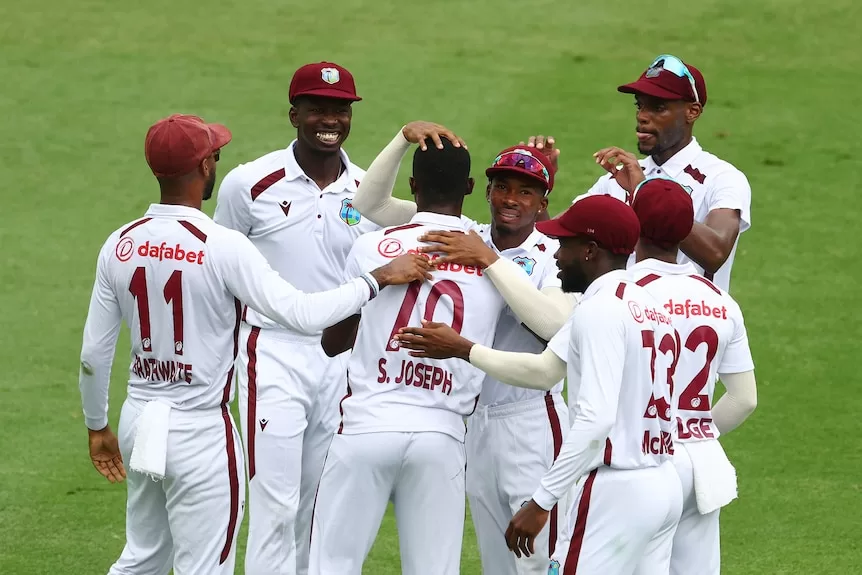None of this was supposed to happen. None of it seemed even remotely possible.
They weren’t even meant to be playing for one, such was the biblical downpour that smashed Brisbane for almost the entire morning. The crowd stayed away as a result — and won’t thousands be kicking themselves for that.
Shamar Joseph wasn’t meant to be bowling, that’s for sure. His right big toe had been obliterated by a Mitchell Starc yorker the night before, to the point where he could not walk himself off the field without support.
The West Indies weren’t meant to get close, certainly not after Steve Smith and Cameron Green calmly picked off the first 45 minutes of the day and half of the runs Australia required.
And then even if Joseph could somehow stand and run and bowl, he surely could not dream of doing it for 10 straight overs, sending them down regularly over 145kph, while blowing Australia’s middle order away on what would become the West Indies’ greatest day for a generation.
Implausible doesn’t even come close to doing it justice. It had to be seen to be believed.
The secret to Test cricket’s enduring appeal is that days like this are rare, but always possible. And they can sneak up on you, the greatest joys coming when your guard is down and you are not anticipating them.
That certainly sums up this day and this match, but could be extended to the West Indies team as a whole.
Most reasonable judges predicted a walkover of a series, the West Indies not nearly well enough equipped for a task of this magnitude. At times that has been true, and a 10-wicket defeat in Adelaide doesn’t make much of a counterargument.
But the Australian public has been taken by this travelling team and the way they play the game. Calypso Summer 2.0 it may not be, but there has been an admiration and fondness for these Windies that is not extended for every visiting side.
Topping the list of new crowd favourites is Shamar Joseph, even before his star turn on day four in Brisbane. He was a revelation in Adelaide, and was lapping up the crowd’s attention through the early days of this Test.
But his performance at the Gabba was something else, quality reserved for the best of the best in this game.
It was heart, athleticism and skill; blood, sweat and tears. It was lightning fast, absolutely captivating. Fast bowling in its purest form, the best thing Test cricket has to offer.
After the game he admitted he wasn’t even planning on turning up to the Gabba for the day that has changed his life. As time goes on, we will learn the extent of his toe injury — give it a few years and we will embellish it well beyond the point of believability.
One by one, the wickets fell and the West Indies’ belief grew. Cameron Green and Travis Head bowled in consecutive balls to wake everyone up. Mitch Marsh caught in the slips and Alex Carey castled to make it feel real.
Then it was up to Australia’s bowlers to try to help Steve Smith do it himself. Mitchell Starc batted recklessly, picking off some quick runs but throwing a vital wicket away in the process. Pat Cummins couldn’t handle Joseph’s pace.
Alzarri Joseph chipped in to get rid of Nathan Lyon, before clearing the stage for Shamar’s crowning moment. The top of Josh Hazlewood’s off stump knocked back, and a celebration for the ages launched.
There were grown men crying in the Gabba, current and former West Indian players alike. It’s the first time they’ve celebrated a Test win in this country for 27 years, and they’ve got a 24-year old dynamo to thank.
On the other side, Australia’s curious decisions and poor batting made for a loss that was unthinkable only a few days ago.
Declaring while behind is a brave move, but one that looks foolish when the team goes on lose by eight runs. There’s probably a reason only two teams have ever won a Test after declaring behind.
Smith carried his bat, a feather in any opener’s cap, but he and his teammates were unable to negotiate the finer details of the run chase.
Too many wickets were lost in clumps, the tactics of the tailenders seemed too haphazard, and it wasn’t until Hazlewood came to the crease after stumps that Smith began manipulating the strike.
In the end it all happened so quickly for the Australians. Cruising with Smith and Cameron Green at the crease, the game turned completely in less than an hour.
It was the sort of collapse that defined previous versions of this team but seemed to have been consigned to history. Perhaps this one can be put down to fatigue, or simply running into the wrong man at the wrong time.
Or it might just be the case that this Test didn’t mean half as much to Australia as it did for the West Indies. And why should it? The Australians aren’t fighting for their future in this format with every ball they bowl, desperate to earn respect and retain relevance in a sport it once dominated.
Australia is already thinking of New Zealand, and then India next summer. Its calendar is unrelenting — hell, these guys have barely finished celebrating World Cup wins, Test World Championships, Ashes retention, everything else in between.
The world of cricket for Australia is massive, and densely populated. For the West Indies there are only slivers to look through, so every glimpse of the light means the world.
The light shone as bright as it has in decades on this day and, thankfully, they shared it all with us. We will never forget this match and series that has once again reminded us of Test cricket’s true value and the special place the West Indies hold within it.
